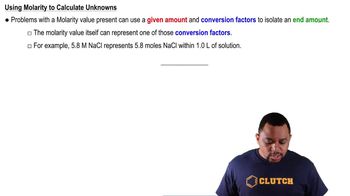The concentration of alcohol 1CH3CH2OH2 in blood, called the 'blood alcohol concentration' or BAC, is given in units of grams of alcohol per 100 mL of blood. The legal definition of intoxication, in many states of the United States, is that the BAC is 0.08 or higher. What is the concentration of alcohol, in terms of molarity, in blood if the BAC is 0.08?
Ch.4 - Reactions in Aqueous Solution

Brown14th EditionChemistry: The Central ScienceISBN: 9780134414232Not the one you use?Change textbook
Chapter 4, Problem 68
In a sugar tolerance test, a patient needs to drink a glucose (C6H12O6) solution containing 100g glucose. Given that one cup is 350 mL, calculate the molarity of glucose in the glucose solution.
 Verified step by step guidance
Verified step by step guidance1
Step 1: Calculate the number of moles of glucose. Use the molar mass of glucose (C_6H_{12}O_6), which is approximately 180.18 g/mol, to convert 100 g of glucose to moles using the formula: \( \text{moles of glucose} = \frac{\text{mass of glucose (g)}}{\text{molar mass of glucose (g/mol)}} \).
Step 2: Convert the volume of the solution from milliliters to liters. Since 1 cup is 350 mL, convert this volume to liters by using the conversion factor: \( 1 \text{ L} = 1000 \text{ mL} \).
Step 3: Calculate the molarity of the glucose solution. Molarity (M) is defined as the number of moles of solute (glucose) per liter of solution. Use the formula: \( M = \frac{\text{moles of solute}}{\text{liters of solution}} \).
Step 4: Substitute the values obtained from Steps 1 and 2 into the molarity formula to find the molarity of the glucose solution.
Step 5: Review the units to ensure they are consistent and correct, confirming that the final unit for molarity is moles per liter (mol/L).
Key Concepts
Here are the essential concepts you must grasp in order to answer the question correctly.
Molarity
Molarity is a measure of concentration defined as the number of moles of solute per liter of solution. It is expressed in moles per liter (mol/L). To calculate molarity, one must know the amount of solute in grams and the volume of the solution in liters. This concept is essential for understanding how concentrated a solution is and is commonly used in chemistry for preparing solutions.
Recommended video:
Guided course

Molarity
Moles and Molar Mass
A mole is a unit in chemistry that represents 6.022 x 10²³ entities, such as atoms or molecules. The molar mass of a substance is the mass of one mole of that substance, typically expressed in grams per mole (g/mol). For glucose (C6H12O6), the molar mass is approximately 180 g/mol. Knowing how to convert grams of a substance to moles is crucial for calculating molarity.
Recommended video:
Guided course

Molar Mass Concept
Volume Conversion
Volume conversion is the process of changing a measurement from one unit to another, such as from milliliters (mL) to liters (L). Since molarity is defined in terms of liters, it is necessary to convert the volume of the solution from mL to L for accurate calculations. For example, 350 mL is equivalent to 0.350 L, which is essential for determining the molarity of the glucose solution.
Recommended video:
Guided course

Common Conversion Factors
Related Practice
Textbook Question
2404
views
Textbook Question
(a) How many grams of ethanol, CH3CH2OH, should you dissolve in water to make 1.00 L of vodka (which is an aqueous solution that is 6.86 M ethanol)? (b) Using the density of ethanol (0.789 g/mL), calculate the volume of ethanol you need to make 1.00 L of vodka.
1548
views
Textbook Question
(a) Which will have the highest concentration of potassium ions: 0.20 M KCl, 0.15 M K2CrO4, or 0.080 M K3PO4?
1459
views
Textbook Question
(b) Which will contain the greater number of moles of potassium ion: 30.0 mL of 0.15 M K2CrO4 or 25.0 mL of 0.080 M K3PO4
406
views
Textbook Question
Indicate the concentration of each ion or molecule present in the following solutions: (a) 0.35 M K3PO4 (b) 1.3×10−2 M MgSO4 (c) 0.0184 M CH3CH2OH
330
views
